Our PDF dumps of 70-341 exam is designed to ensure everything which you need to pass your exam successfully. At GreatExam, we have a completely customer oriented policy. We invite the professionals who have rich experience and expert knowledge of the IT certification industry to guarantee the PDF details precisely and logically. Our customers’ time is a precious concern for us. This requires us to provide you the products that can be utilized most efficiently.
QUESTION 71
You need to recommend a solution to resolve the issue for the London office users.
What should you do?
A. Modify the properties of the OAB virtual directory.
B. Create a new address book policy.
C. Modify the properties of the default offline address book (OAB).
D. Create a new arbitration mailbox.
Answer: D
Explanation:
NOT A
Will not resolve the issue
Need to create a new arbirtration mailbox
NOT B
Will not resolve the issue
Need to create a new arbirtration mailbox
NOT C
Will not resolve the issue
Need to create a new arbirtration mailbox
D
Exchange Server 2013 CAS role proxies the OAB download request to a “nearest” mailbox server hosting an active Organization Mailbox.
Both London and New York host a mailbox server and a client access server.
Therefore you need to create a new active Organization Mailbox Administrators can create additional Organization Mailboxes for fault tolerance or for serving users in a geographically disbursed Exchange deployment.
The Organization Mailbox
The Organization Mailbox is a new type of arbitration mailbox introduced with Exchange 2013.
The arbitration mailbox with persisted capability OrganizationCapabilityOABGen is referred to as Organization Mailbox. It plays a crucial role in OAB generation, storage and distribution.
Each Exchange Server 2013 mailbox role hosting an Organization Mailbox will generate all Exchange 2013 OAB’s defined in the environment. The OAB is generated in the Organization Mailbox first and later copied to the disk.
http://technet.microsoft.com/en-us/library/aa997663(v=exchg.150).aspx
QUESTION 72
You have an Exchange Server 2013 organization that contains five servers.
All users connect to their mailbox by using a mobile device.
All of the users in the finance department are in an organizational unit (OU) named OU1.
You need to prevent the finance users from accessing the extended storage on their mobile device.
What should you do?
A. Create a new mobile device mailbox policy, and then run the Set-CasMailbox cmdlet.
B. Create a new device access rule, and then run the Set-Mailbox cmdlet.
C. Create a new mobile device mailbox policy, and then run the Set-Mailbox cmdlet.
D. Create a new device access rule, and then run the Set-CasMailbox cmdlet.
Answer: A
Explanation:
Set-CASMailbox cmdlet
Use the Set-CASMailbox cmdlet to set attributes related to client access for Microsoft Exchange ActiveSync, Microsoft Office Outlook Web App, POP3, and IMAP4 for a specified user. The Set-CASMailbox cmdlet operates on one mailbox at a time. You can configure properties for Outlook Web App, Exchange ActiveSync, POP3, and IMAP4 by using this cmdlet. You can configure a single property or multiple properties by using one statement.
Set-Mailbox cmdlet.
Use the Set-Mailbox cmdlet to modify the settings of an existing mailbox.
You can use this cmdlet for one mailbox at a time.
Mobile device mailbox policy
In Microsoft Exchange Server 2013, you can create mobile device mailbox policies to apply a common set of policies or security settings to a collection of users. After you deploy Exchange ActiveSync in your Exchange 2013 organization, you can create new mobile device mailbox policies or modify existing policies. When you install Exchange 2013, a default mobile device mailbox policy is created. All users are automatically assigned this default mobile device mailbox policy.
Device access rule
Use device access rules to allow users to synchronize their mailboxes with specific mobile device families or models.
NOT B C
Use the Set-CASMailbox cmdlet to set attributes related to client access for Microsoft Exchange ActiveSync, Microsoft Office Outlook Web App, POP3, and IMAP4 for a specified user.
NOT D
In Microsoft Exchange Server 2013, you can create mobile device mailbox policies to apply a common set of policies or security settings to a collection of users
QUESTION 73
You have an Exchange Server 2013 server that has a single mailbox database named DB1.
You need to move the transaction log files of DB1.
Which cmdlet should you run?
A. Move-DatabasePath
B. Move-Mailbox
C. Set-ExchangeServer
D. Set-MailboxDatabase
Answer: A
QUESTION 74
You have an Exchange Server 2013 organization named contoso.com.
Your company is Investigating a user named User1.
You need to prevent User1 from permanently deleting the items in his mailbox.
What should you run?
A. Set-Mailbox User1 -LitigationHoldEnabled $true
B. Set-Mailbox User1 -ModerationEnabled $true
C. Set-Mailbox User1 -RetainDeletedItemsUntilBackup $true
D. Set-Mailbox User1 -RetentionHoldEnabled $true
Answer: A
QUESTION 75
You have an Exchange 2013 organization.
You have an administrative user named Admin1.
You need to ensure that Admin1 can move mailboxes in the organization.
The solution must assign the minimum amount of permissions to Admin1.
What should you do?
A. Create a local move request.
B. Create a custom Management role. Assign the role to Admin1.
C. Add Admin1 to the Organization Management role group.
D. Add Admin1 to the Recipient Management security group.
Answer: B
QUESTION 76
Hotspot Question
Your company has two offices.
The offices are configured as shown in the following table.
The offices connect to each other by using a WAN link that has a latency of more than 700 ms. You plan to deploy an Exchange Server 2013 organization to meet the following requirements:
– Ensure that users can access their mailbox if the WAN link fails.
– Ensure that users can access their mailbox if a single server fails.
– Ensure that users can access their mailbox if a single database fails.
You recommend deploying one or more database availability groups (DAGs) and mailbox database copies.
You need to identify which design meets the requirements for the planned deployment.
Which design should you identify? To answer, select the appropriate design in the answer area.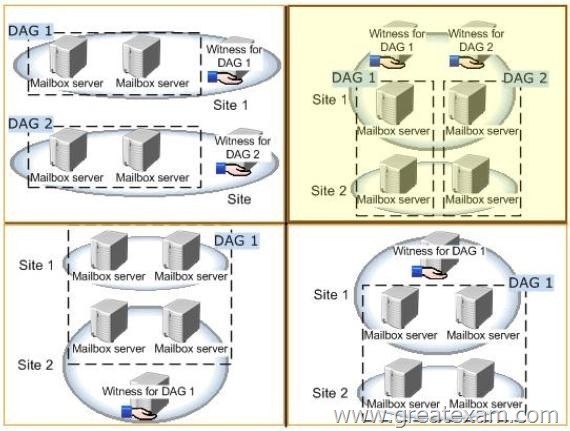
Answer:
Explanation:
File Share Witness
The file share witness is used to establish a majority node set. This is done by create a share on a server that gets a little file place into it automatically. The server hosting the cluster resource (which in the DAG I think is the Primary Activation Manager server) keeps an open file lock on this file.
The other servers see this open file lock and interpret this as meaning another cluster node is online, healthy, and available.
A file share witness is used when the DAG contains an even number of servers within it. When you initially create the DAG you must specify the server and file location that will act as the file share witness regardless of how many servers are in the DAG (0 to start) to ensure that if you do add an even number of DAG members the FSW will be properly used.
Database Availability Group
A database availability group (DAG) is a set of up to 16 Microsoft Exchange Server 2013 Mailbox servers that provide automatic database-level recovery from a database, server, or network failure. When a Mailbox server is added to a DAG, it works with the other servers in the DAG to provide automatic, database-level recovery from database, server, and network failures. DAGs use continuous replication and a subset of Windows failover clustering technologies to provide high availability and site resilience.
Mailbox servers in a DAG monitor each other for failures. When a Mailbox server is added to a DAG, it works with the other servers in the DAG to provide automatic, database-level recovery from database failures.
When you create a DAG, it’s initially empty, and a directory object is created in Active Directory that represents the DAG. The directory object is used to store relevant information about the DAG, such as server membership information. When you add the first server to a DAG, a failover cluster is automatically created for the DAG. In addition, the infrastructure that monitors the servers for network or server failures is initiated. The failover cluster heartbeat mechanism and cluster database are then used to track and manage information about the DAG that can change quickly, such as database mount status, replication status, and last mounted location. Witness server and witness directory The witness server is a server outside the DAG that acts as a quorum voter when the DAG contains an even number of members. The witness directory is a directory created and shared on the witness server for use by the system in maintaining a quorum.
Lagged copy of a mailbox database
A Lagged Mailbox Database Copy is a mailbox database copy configured with a replay lag time value greater than 0.
A lagged database copy is one that is not updated by replaying transactions as they become available.
Instead, the transaction logs are kept for a certain period and are then replayed. The lagged database copy is therefore maintained at a certain remove to the active database and the other non-lagged database copies. If you are planning to have more than two passive database copies of a database, think about a lagged copy also as an additional protection against unpredicted situations Lagged copies aren’t considered highly available copies. Instead, they are designed for disaster recovery purposes, to protect against store logical corruption. The greater the replay lag time set, the longer the database recovery process. Depending on the number of log files that need to replayed during recovery, and the speed at which your hardware can replay them, it may take several hours or more to recover a database.
The above configuration provides a symmetrical design.
All four servers have the same four databases all hosted on a single disk per server.
The key is that the number of copies of each database that you have should be equal to the number of database copies per disk.
In the above example, there are four copies of each database: one active copy, two passive copies, and one lagged copy. Because there are four copies of each database, the proper configuration is one that has four copies per volume. In addition, activation preference is configured so that it’s balanced across the DAG and across each server.
For example, the active copy will have an activation preference value of 1, the first passive copy will have an activation preference value of 2, the second passive copy will have an activation preference value of 3, and the lagged copy will have an activation preference value of 4.
Lagged mailbox database copy
A passive mailbox database copy that has a log replay lag time greater than zero.
Crossed Lines
DAG Replication 1 and 2
Circled Areas
Site 1 and Site 2 (or DataCenter1 and DataCenter2)
WAN LINK between Site1 and Site2
High Availability with Site Resiliency Exchange 2010 Example
http://jaworskiblog.com/2011/05/17/exchange-2010-design-principles-for-high-availability-and-site-resiliency/
FSW is the File Share Witness
ASIDE
Windows NLB is not supported across sites.
It is not recommended to use an HLB to load balance across sites.
PICTURE1 OFFERS THE BEST DESIGN IN ORDER TO MEET THE SPECIFIED CRITERIA.
MORE FAULTS WITH THE OTHERS.
PICTURE1 HOWEVER DOES NOT OFFER SITE RESILIENCY.
– Ensure that users can access their mailbox if the WAN link fails.
– Ensure that users can access their mailbox if a single server fails.
– Ensure that users can access their mailbox if a single database fails.
Picture1
The DAG is NOT extended across multiple data centers in a site resilience configuration.
The design offers high availability within each site.
However if a node fails or the wan link fails the respective file share witness for each DAG is still available unlike the other 3 configurations.
Picture2
The DAG is extended across multiple data centers in a site resilience configuration.
No high availability within each site.
If the wan link is unavailable the file share witness for Site2 would be unavailable This is a split brain scenario, both sites believe that they are the rightful owner of the database, and thus would mount their respective DB’s. This would cause a divergence in data. Email could be sent to either database leaving to a difference between the databases on the respective mailbox servers.
Picture3
The DAG is extended across multiple data centers in a site resilience configuration. FSW on Site2 in the event of a wan failure means that the servers cannot contact a FSW Even number of nodes on the respective site with an inability to contact the FSW. This is a split brain scenario, both sites believe that they are the rightful owner of the database, and thus would mount their respective DB’s. This would cause a divergence in data. Email could be sent to either database leaving to a difference between the databases on the respective mailbox servers.
A file share witness is used when the DAG contains an even number of servers within it. A Node Majority quorum model is used for DAGs with an odd number of members. A Node and File Share Majority quorum is used for DAGs with an even number of members.
The DAG needs to be able to make Quorum.
When 1 node fails in Site1 and the wan link is down,1 out of 2 nodes left is not a majority. Need to be able to connect to the file share witness to obtain a majority.
Picture4
1 DAG across both sites provides site resiliency but FSW on Site1 in the event of a wan failure means that the servers cannot contact a FSW A file share witness is used when the DAG contains an even number of servers within it.
Even number of nodes on the respective site with an inability to contact the FSW. This is a split brain scenario, both sites believe that they are the rightful owner of the database, and thus would mount their respective DB’s. This would cause a divergence in data. Email could be sent to either database leaving to a difference between the databases on the respective mailbox servers.
A file share witness is used when the DAG contains an even number of servers within it. A Node Majority quorum model is used for DAGs with an odd number of members. A Node and File Share Majority quorum is used for DAGs with an even number of members.
QUESTION 77
You deploy a server that has the Exchange Server 2013 Mailbox server role and Client Access server role installed.
You need to configure anti-spam to meet the following requirements:
– Email messages sent from the Internet to a distribution list named Executives must be rejected.
– Email messages that contain the words casino and jackpot must be rejected, unless they were sent to [email protected].
Which three cmdlets should you run? (Each correct answer presents part of the solution. Choose three.)
A. Add ContentFilterPhrase
B. Set-ContentFilterConfig
C. Set-TransportConfig
D. Set-SenderReputationConfig
E. Set-RecipientFilterConfig
Answer: ABE
Explanation:
Add ContentFilterPhrase
The Add-ContentFilterPhrase cmdlet adds phrases to the Allow or Block phrases list. Use the Add-ContentFilterPhrase cmdlet to define custom words for the Content Filter agent. A custom word is a word or phrase that the administrator sets for the Content Filter agent to evaluate the content of an e-mail message and apply appropriate filter processing.
Syntax
Examples
EXAMPLE 1
This example adds the phrase Free credit report to the Block phrase list. Any messages that contain this phrase will be marked as spam by the Content Filtering agent. Add-ContentFilterPhrase -Phrase “Free credit report” -Influence BadWord Set-ContentFilterConfig
Use the Set-ContentFilterConfig cmdlet to modify the content filter configuration on a Mailbox server or an Edge Transport server.
Syntax
Set-ContentFilterConfig [-BypassedRecipients <MultiValuedProperty>] [-BypassedSenderDomains <MultiValuedProperty>] [-BypassedSenders <MultiValuedProperty>] [-Confirm [<SwitchParameter>]] [-DomainController <Fqdn>] [-Enabled <$true | $false>] [-ExternalMailEnabled <$true | $false>] [-InternalMailEnabled <$true | $false>] [-OutlookEmailPostmarkValidationEnabled <$true | $false>] [-QuarantineMailbox <SmtpAddress>] [-RejectionResponse <AsciiString>] [-SCLDeleteEnabled <$true | $false>]
[-SCLDeleteThreshold <Int32>] [-SCLQuarantineEnabled <$true | $false>] [-SCLQuarantineThreshold <Int32>]
[-SCLRejectEnabled <$true | $false>] [-SCLRejectThreshold <Int32>] [-WhatIf [<SwitchParameter>]]
EXAMPLE 1
This example specifies the sender domain woodgrovebank.com as a bypassed domain. Messages received from that domain bypass the Content Filter agent.
Set-ContentFilterConfig -BypassedSenderDomains woodgrovebank.com Set-RecipientFilterConfig
Use the Set-RecipientFilterConfig cmdlet to enable and configure the Recipient Filter agent.
Syntax
Set-RecipientFilterConfig [-BlockedRecipients <MultiValuedProperty>] [-BlockListEnabled <$true | $false>] [-Confirm [<SwitchParameter>]] [-DomainController <Fqdn>] [-Enabled <$true | $false>] [-ExternalMailEnabled<$true | $false>] [-InternalMailEnabled <$true | $false>] [-RecipientValidationEnabled <$true | $false>] [-WhatIf
[<SwitchParameter>]]
EXAMPLE 1
This example modifies the Recipient Filter agent configuration so that recipient validation is enabled.
Set-RecipientFilterConfig -RecipientValidationEnabled $true
EXAMPLE 2
This example makes the following changes to the Recipient Filter agent configuration:
Enables the Blocked Recipients list.
Adds two users to the Blocked Recipients list.
Set-RecipientFilterConfig -BlockListEnabled $true 瑽lockedRecipients [email protected],[email protected]
NOT C Set-TransportConfig
Use the Set-TransportConfig cmdlet to modify the transport configuration settings for the whole Exchange organization.
This example configures the Exchange organization to redirect all journaling reports that can’t be delivered to the journaling mailbox to the email account [email protected].
Set-TransportConfig -JournalingReportNdrTo [email protected]
NOT D Set-SenderReputationConfig
Use the Set-SenderReputationConfig cmdlet to modify the sender reputation configuration on a Mailbox server or an Edge Transport server.
Sender reputation is part of the Exchange anti-spam functionality that blocks messages according to many characteristics of the sender.
Sender reputation relies on persisted data about the sender to determine what action, if any, to take on an inbound message. The Protocol Analysis agent is the underlying agent for sender reputation functionality.
When you configure anti-spam agents on an Exchange server, the agents act on messages cumulatively to reduce the number of unsolicited messages that enter the organization.
Syntax
EXAMPLE 1
This example makes the following modifications to the sender reputation configuration:
It sets the sender reputation action to block all senders whose sender reputation level (SRL) rating exceeds the SRL threshold.
It sets the SRL blocking threshold to 6.
It sets the number of hours that senders are put on the blocked senders list to 36 hours. Set-SenderReputationConfig -SenderBlockingEnabled $true -SrlBlockThreshold 6 -SenderBlockingPeriod 36
QUESTION 78
Your company named Contoso, Ltd., has an Exchange Server 2013 organization named contoso.com.
The network contains an Active Directory domain.
The domain contains an organizational unit (OU) named SalesOU.
SalesOU contains two users named User1 and User2.
Contoso purchases a domain name adatum.com.
You need to change the primary SMTP address of all the users in SalesOU to use the SMTP suffix of adatum.com.
The solution must not remove the contoso.com email address.
Which two actions should you perform? (Each correct answer presents part of the solution. Choose two.)
A. Create a new email address policy and apply the policy to the users in SalesOU.
B. Change the default email address policy to include adatum.com.
C. Create a new remote domain for adatum.com.
D. Create a new accepted domain for adatum.com and set the domain type to Authoritative Domain.
E. Create a new accepted domain for adatum.com and set the domain type to External RelayDomain.
Answer: AD
Explanation:
Email Address Policies
Applies to: Exchange Server 2013
Recipients (which include users, resources, contacts, and groups) are any mail-enabled object in Active Directory to which Microsoft Exchange can deliver or route messages. For a recipient to send or receive email messages, the recipient must have an email address. Email address policies generate the primary and secondary email addresses for your recipients so they can receive and send email.
By default, Exchange contains an email address policy for every mail-enabled user. This default policy specifies the recipient’s alias as the local part of the email address and uses the default accepted domain. The local part of an email address is the name that appears before the at sign (@). However, you can change how your recipients’ email addresses will display. For example, you can specify that the addresses display as [email protected].
Furthermore, if you want to specify additional email addresses for all recipients or just a subset, you can modify the default policy or create additional policies. For example, the user mailbox for David Hamilton can receive email messages addressed to [email protected] and [email protected].
Looking for management tasks related to email address policies See Email Address Policy Procedures.
NOT B
No need to change the default email policy.
Create a new email address policy
NOT C
No need for a remote domain
You can create remote domain entries to define the settings for message transfer between the Microsoft Exchange Server 2013 organization and domains outside your Exchange organization.
When you create a remote domain entry, you control the types of messages that are sent to that domain. You can also apply message format policies and acceptable character sets for messages that are sent from users in your organization to the remote domain. The settings for remote domains are global configuration settings for the Exchange organization.
The remote domain settings are applied to messages during categorization in the Transport service on Mailbox servers. When recipient resolution occurs, the recipient domain is matched against the configured remote domains. If a remote domain configuration blocks a specific message type from being sent to recipients in that domain, the message is deleted. If you specify a particular message format for the remote domain, the message headers and content are modified. The settings apply to all messages that are processed by the Exchange organization.
NOT E
Do not want to use a relay server. When you configure an external relay domain, messages are relayed to an email server that’s outside your Exchange organization and outside the organization’s network perimeter.
Typically, most Internet-facing messaging servers are configured to not allow for other domains to be relayed through them.
However, there are scenarios where you may want to let partners or subsidiaries relay email through your Exchange servers. In Exchange 2013, you can configure accepted domains as relay domains. Your organization receives the email messages and then relays the messages to another email server.
You can configure a relay domain as an internal relay domain or as an external relay domain. These two relay domain types are described in the following sections.
A
Need to create a new email address policy
D
There are three types of accepted domains: authoritative, internal relay, and external relay. Configure an Accepted Domain within Your Exchange Organization as Authoritative Applies to: Exchange Server 2013 If a domain belonging to your organization hosts mailboxes for all the recipients within an SMTP namespace, that domain is considered to be authoritative.
By default, one accepted domain is configured as authoritative for the Exchange organization.
If your organization has more than one SMTP namespace, you can configure more than one accepted domain as authoritative.
Configure an Accepted Domain within Your Exchange Organization as Authoritative:
Exchange 2013 Help
QUESTION 79
Drag and Drop Question
You have an Exchange Server 2013 organization named Contoso.
The organization is configured to apply a disclaimer to all email messages sent to external recipients.
Your company works with a partner company named A. Datum Corporation.
A. Datum has an SMTP domain named adatum.com.
You need to ensure that email messages sent to adatum.com meet the following compliance requirements:
– Messages sent to adatum.com must NOT include the disclaimer.
– Messages that contain credit card numbers must NOT be sent to adatum.com.
– If a user writes a message that contains a credit card number and the message is addressed to a recipient at adatum.com, the user must receive a notification before the message is sent.
What should you configure for each requirement? To answer, drag the appropriate configuration to the correct requirement in the answer area. Each configuration may be used once, more than once, or not at all. Additionally, you may need to drag the split bar between panes or scroll to view content.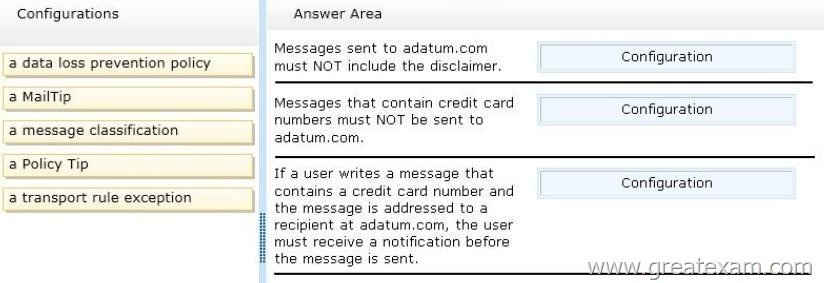
Answer: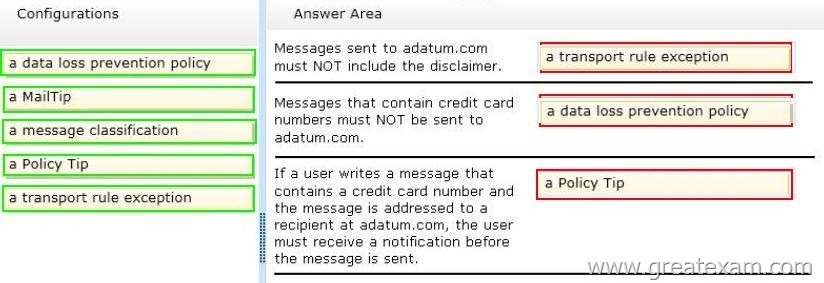
Explanation:
Box 1: A transport rule exception
Box 2: A data loss prevention policy
Box 3: a Policy Tip
Note:
– Each transport rule can have exceptions that specify what to exclude from the condition. Exceptions typically determine a subset of criteria identified in the condition. If you use transport rules, you can specify what information you don’t want to enter or leave the organization, which individuals or groups shouldn’t be able to communicate with one another, how messages are handled based on how they are classified by the sender, and more.
– The Data loss prevention (DLP) feature in the new Exchange will help you identify, monitor, and protect sensitive information in your organization through deep content analysis. DLP is increasingly important for enterprise message systems because business critical email includes sensitive data that needs to be protected. It’s the financial information, personally identifiable information (PII) and intellectual property data that can be accidently sent to unauthorized users that keeps the CSO up all night.
– Policy Tip notification messages are displayed to users in Outlook while they are composing an email message. Policy Tip notification messages only show up if something about the sender’s email message seems to violate a DLP policy that you have in place and that policy includes a rule to notify the sender when the conditions that you establish are met.
– Incorrect: MailTips are evaluated every time a sender adds a recipient to a message. Reference: Introducing Data Loss Prevention in the New Exchange; Policy Tips
QUESTION 80
Drag and Drop Question
You have an Exchange Server 2013 organization that contains three servers named EX1, EX2, and EX3.
The servers are members of a database availability group (DAG) named DAG1.
A mailbox database named DB1 is replicated to all the members of DAG1.
EX3 experiences a complete hardware failure.
You need to restore EX3 on a new server.
You reset the computer account for EX3.
Which three actions should you perform next? To answer, move the three appropriate actions from the list of actions to the answer area and arrange them in the correct order.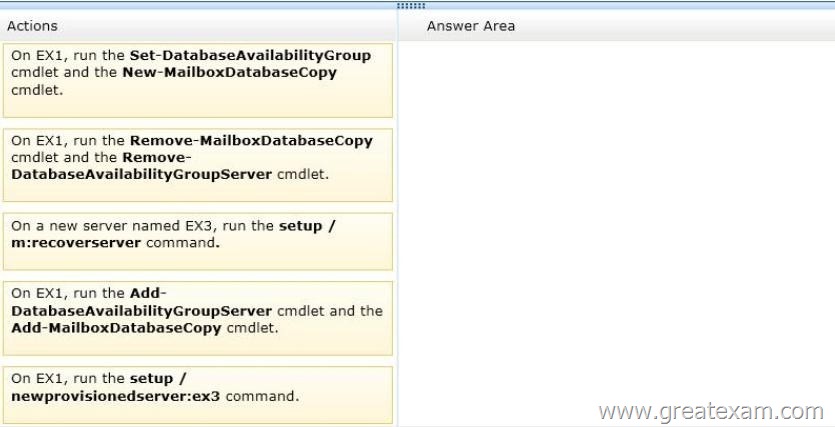
Answer: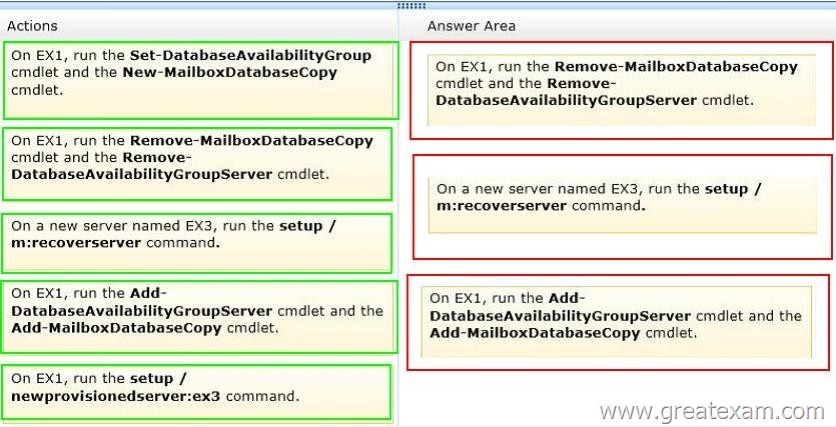
Explanation:
Note: Use Setup /m:RecoverServer to recover a server
Retrieve any replay lag or truncation lag settings for any mailbox database copies that exist on the server being recovered by using the Get-MailboxDatabase cmdlet.
(Box 1) Remove any mailbox database copies that exist on the server being recovered by using theRemove-MailboxDatabaseCopy cmdlet.
(Box 1) Remove the failed server’s configuration from the DAG by using the Remove-DatabaseAvailabilityGroupServer cmdlet.
Reset the server’s computer account in Active Directory.
For detailed steps, see Reset a Computer Account.
(Box 2) Open a Command Prompt window. Using the original Setup media, run the following command.
Setup /m:RecoverServer
(Box 3) When the Setup recovery process is complete, add the recovered server to the DAG by using the Add-DatabaseAvailabilityGroupServer cmdlet.
(Box 3) After the server has been added back to the DAG, you can reconfigure mailbox database copies by using the Add-MailboxDatabaseCopy cmdlet.
* You can recover a lost server by using the Setup /m:RecoverServer switch in Microsoft Exchange Server 2013. Most of the settings for a computer running Exchange 2013 are stored in Active Directory. The /m:RecoverServer switch rebuilds an Exchange server with the same name by using the settings and other information stored in Active Directory.
Reference: Recover a Database Availability Group Member Server
QUESTION 81
Your company has offices in Miami, Singapore and Montreal.
An Active Directory site exists for each office.
You have an Exchange Server 2013 organization that contains a server in each site.
Each server has the Mailbox server role and the Client Access Server role installed.
All users connect to the Miami servers to retrieve the public folder hierarchy.
You need to create several public folders on the server in the Singapore office to meet the following requirements:
– Ensure that the public folders are available if a single Mailbox server fails.
– Ensure that the users in the Singapore office connect to their local server to retrieve the public folder hierarchy.
Which actions should you perform? (Each correct answer presents part of the solution. Choose all that apply.)
A. Create a new public folder mailbox.
B. Create a new public folder database.
C. Run the Add-MailboxDatabaseCopy cmdlet.
D. For each mailbox in the Singapore office, run the Set-Mailbox cmdlet and specify the -defaultpublicfoldermailbox parameter.
E. Run the Set-PublicFolderDatabase cmdlet.
F. For each public folder mailbox, run the Set-Mailbox cmdlet and specify the -defaultpublicfoldermailbox parameter.
Answer: ACD
Explanation:
Public Folders
Public folders can also be used as an archiving method for distribution groups. When you mail- enable a public folder and add it as a member of the distribution group, email sent to the group is automatically added to the public folder for later reference.
Public folders are designed for shared access and provide an easy and effective way to collect, organize, and share information with other people in your workgroup or organization.
Public folders help organize content in a deep hierarchy that’s easy to browse. Users will see the full hierarchy in Outlook, which makes it easy for them to browse for the content they’re interested in.
Public folder architecture
In Exchange 2013, public folders were re-engineered using mailbox infrastructure to take advantage of the existing high availability and storage technologies of the mailbox database. Public folder architecture uses specially designed mailboxes to store both the public folder hierarchy and the content. This also means that there’s no longer a public folder database. High availability for the public folder mailboxes is provided by a database availability group (DAG).
NOT B
In Exchange 2013, public folders were re-engineered using mailbox infrastructure to take advantage of the existing high availability and storage technologies of the mailbox database.
Public folder architecture uses specially designed mailboxes to store both the public folder hierarchy and the content. This also means that there’s no longer a public folder database
There is no database-level setting in Exchange 2013. Exchange 2013 has a mailbox-level ability to specify the public folder mailbox, but by default Exchange auto-calculates the per-user hierarchy mailbox.
NOT E
http://technet.microsoft.com/en-us/library/aa997225(v=exchg.141).aspx
Use the Set-PublicFolderDatabase cmdlet to set attributes of public folder databases (Exchange Server 2010)
There’s no longer a public folder database in Exchange Server 2013.
There is no database-level setting in Exchange 2013. Exchange 2013 has a mailbox-level ability to specify the public folder mailbox, but by default Exchange auto-calculates the per-user hierarchy mailbox.
NOT F
Need to set it in the Singapore Office.
Miami users still use the Miami servers to connect to the public folder hiearchy.
A
Need to create a public folder mailbox in the Singapore office.
Public folder architecture uses specially designed mailboxes to store both the public folder hierarchy and the content. This also means that there’s no longer a public folder database
C
Use the Add-MailboxDatabaseCopy cmdlet to create a passive copy of an existing active mailbox database.
The specified Mailbox server must be in the same database availability group (DAG), and the DAG must have quorum and be healthy.
D
Use the Set-MailboxServer cmdlet to modify attributes on a computer running Microsoft Exchange Server 2013 with the Mailbox server role installed.
In Exchange 2007 and Exchange 2010, you could specify which users had access to specific public folders. In Exchange 2013, you can set the default public folder mailbox per user.
To do so, run the Set-Mailbox cmdlet with the DefaultPublicFolderMailbox parameter.
This ensures that the users in the Singapore office connect to their local server to retrieve the public folder hierarchy.
QUESTION 82
Drag and Drop Question
Your company plans to deploy an Exchange Server 2013 organization.
The network contains an Active Directory forest.
The forest contains two domains named contoso.com and child.contoso.com.
The forest contains one Active Directory site.
To contoso.com, you plan to deploy two servers that have Exchange Server 2013 installed.
To child.contoso.com, you plan to deploy two servers that have Exchange Server 2013 installed. To the contoso.com domain, you deploy a new member server named Server1 that runs Windows Server 2012.
You need to prepare the forest for the planned deployment of Exchange Server 2013.
Which three commands should you run from Server1? To answer, move the three appropriate commands from the list of commands to the answer area and arrange them in the correct order.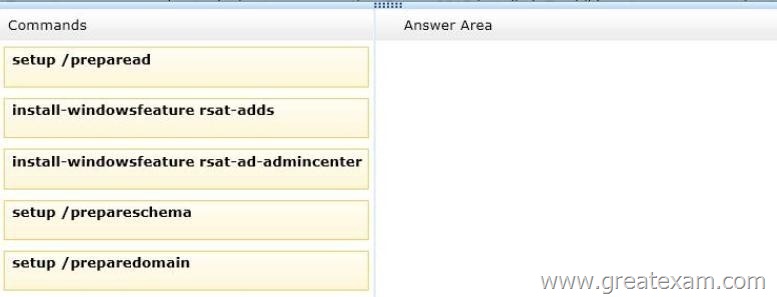
Answer: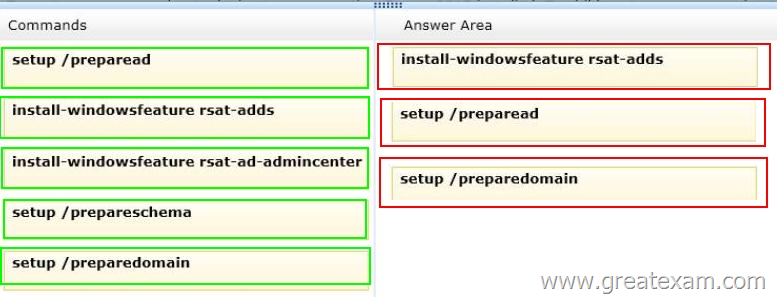
QUESTION 83
You have an Exchange Server 2013 organization.
You need to ensure that an administrator named Admin1 receives a daily email message that contains a log of all the Exchange Server administrative actions.
Which cmdlet should you use in a scheduled task?
A. Set-AdminAuditLogConfig
B. Write-AdminAuditLog
C. New-AdminAuditLogSearch
D. Search-AdminAuditLog
Answer: C
Explanation:
New-AdminAuditLogSearch: Exchange 2013 Help
QUESTION 84
Drag and Drop Question
Your network contains four servers.
The servers are configured as shown in the following table.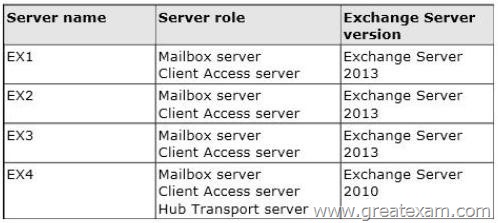
You create a new user account for a temporary user named User1.
You plan to create a new mailbox for User1.
You need to recommend which actions must be performed to ensure that User1 can modify only the values of his home phone number attribute and his office location attribute.
In which order should you perform the actions? To answer, move all actions from the list of actions to the answer area and arrange them in the correct order.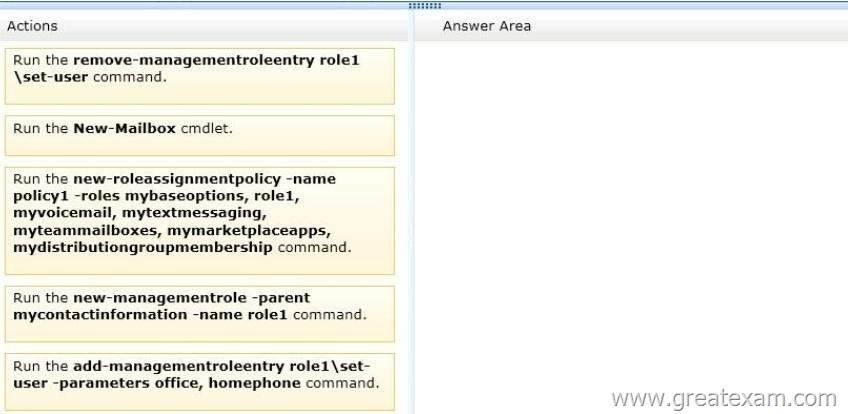
Answer: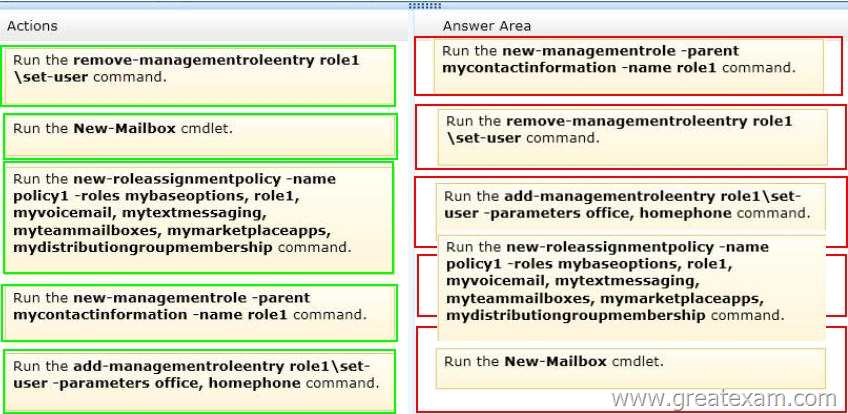
QUESTION 85
Drag and Drop Question
You have an Exchange Server 2013 organization that contains several custom RBAC management roles.
You need to identify which RBAC scopes must be used to meet the following requirements:
– Manage only the mailboxes of the users in the sales department.
– Manage the properties of all the mailbox databases.
Which RBAC scopes should you identify? (To answer, drag the appropriate RBAC scopes to the correct requirements. Each RBAC scope may be used once, more than once, or not at all. You may need to drag the split bar between panes or scroll to view content.)
Answer:
Explanation:
http://technet.microsoft.com/en-us/library/dd335146(v=exchg.150).aspx
Management role scopes enable you to define the specific scope of impact or influence of a management role when a management role assignment is created. When you apply a scope, the role assignee assigned to the role can only modify the objects contained within that scope.
A role assignee can be a management role group, management role, management role assignment policy, user, or universal security group (USG)
Every management role, whether it’s a built-in role or a custom role, has management scopes.
Management scopes can be either of the following:
Regular
A regular scope isn’t exclusive. It determines where, in Active Directory, objects can be viewed or modified by users assigned the management role. In general, a management role indicates what you can create or modify, and a management role scope indicates where you can create or modify. Regular scopes can be either implicit or explicit scopes, both of which are discussed later in this topic.
Exclusive
An exclusive scope behaves almost the same as a regular scope. The key difference is that it enables you to deny users access to objects contained within the exclusive scope if those users aren’t assigned a role associated with the exclusive scope. All exclusive scopes are explicit scopes, which are discussed later in this topic.
Scopes can be inherited from the management role, specified as a predefined relative scope on a management role assignment, or created using custom filters and added to a management role assignment.
Scopes inherited from management roles are called implicit scopes while predefined and custom scopes are called explicit scopes.
Implicit scopes are the default scopes that apply to a management role type. Because implicit scopes are associated with a management role type, all of the parent and child management roles with the same role type also have the same implicit scopes.
Implicit scopes apply to both built-in management roles and also to custom management roles.
Implicit scopes defined on management roles
Implicit scopes Description
Organization If Organization is present in the role’s recipient write scope, the role can create or modify recipient objects across the Exchange organization.
If Organization is present in the role’s recipient read scope, roles can view any recipient object across the Exchange organization.
This scope is used only with recipient read and write scopes. MyGAL If MyGAL is present in the role’s recipient write scope, the role can view the properties of any recipient within the current user’s global address list (GAL). If MyGAL is present in the role’s recipient read scope, the role can view the properties of any recipient within the current GAL.
This scope is used only with recipient read scopes.
Self If Self is present in the role’s recipient write scope, the role can modify only the properties of the current user’s mailbox.
If Self is present in the role’s recipient read scope, the role can view only the properties of the current user’s mailbox.
This scope is used only with recipient read and write scopes.
MyDistributionGroups
If MyDistributionGroups is present in the role’s recipient write scope, the role can create or modify distribution list objects owned by the current user. If MyDistributionGroups is present in the role’s recipient read scope, the role can view distribution list objects owned by the current user.
This scope is used only with recipient read and write scopes. OrganizationConfig
If OrganizationConfig is present in the role’s configuration write scope, the role can create or modify any server or database configuration object across the Exchange organization.
If OrganizationConfig is present in the role’s configuration read scope, the role can view any server or database configuration object across the Exchange organization. This scope is used only with configuration read and write scopes. None If None is in a scope, that scope isn’t available to the role. For example, a role that has None in the recipient write scope can’t modify recipient objects in the Exchange organization. Explicit scopes are scopes that you set yourself to control which objects a management role can modify. Although implicit scopes are defined on a management role, explicit scopes are defined on a management role assignment.
This enables the implicit scopes to be applied consistently across all management roles unless you choose to use an overriding explicit scope. For more information about management role assignments, see Understanding Management Role Assignments. Explicit scopes override the implicit write and configuration scopes of a management role. They don’t override the implicit read scope of a management role. The implicit read scope continues to define what objects the management role can read.
Explicit scopes are useful when the implicit write scope of a management role doesn’t meet the needs of your business. You can add an explicit scope to include nearly anything you want as long as the new scope doesn’t exceed the bounds of the implicit read scope. The cmdlets that are part of a management role must be able to read information about the objects or containers that contain objects for the cmdlets to create or modify objects. For example, if the implicit read scope on a management role is set to Self, you can’t add an explicit write scope of Organization because the explicit write scope exceeds the bounds of the implicit read scope.
The OrganizationConfig implicit scope
If OrganizationConfig is present in the role’s configuration write scope, the role can create or modify any server or database configuration object across the Exchange organization.
If OrganizationConfig is present in the role’s configuration read scope, the role can view any server or database configuration object across the Exchange organization.
CAN MANAGE THE PROPERTIES OF ALL OF THE MAILBOX DATABASES. The Self Implicit Scope If Self is present in the role’s recipient write scope, the role can modify only the properties of the current user’s mailbox.
If Self is present in the role’s recipient read scope, the role can view only the properties of the current user’s mailbox.
CANNOT BE SELF AS IT PERTAINS TO ONLY THE PARTICULAR USER’S MAILBOX
The Organization relative scope
If Organization is present in the role’s recipient write scope, the role can create or modify recipient objects across the Exchange organization.
If Organization is present in the role’s recipient read scope, roles can view any recipient object across the Exchange organization.
This scope is used only with recipient read and write scopes.
NOT MEANT FOR MANAGING MAILBOX DATABASES
A recipient is any mail-enabled object in the Active Directory directory service to which Exchange can deliver or route messages.
In Microsoft Exchange recipients are comprised of mailbox users, mail-enabled users, mail contacts, distribution groups, security groups, dynamic distribution groups, and mail-enabled public folders.
The Recipient filter explicit scope
Recipient filter scopes use filters to target specific recipients based on recipient type or other recipient properties such as department, manager, location, and more.
CAN TARGET THE USERS IN THE SALES DEPARTMENT
If you want to get more 70-341 exam preparation material, you can download the free 70-341 braindumps in PDF files on GreatExam. It would be great helpful for your exam. All the 70-341 dumps are updated and cover every aspect of the examination. Welcome to choose.